Jump to: July 2003 October 2003 November 2003 March 2004 April 2004 May 2004 June 2004
Notes
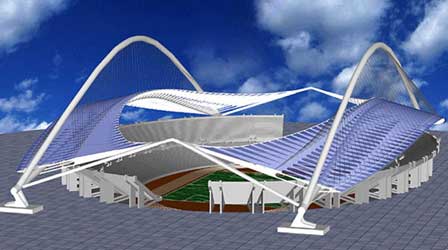
Artists impression of the completed Olympic Stadium
- July 2003 -
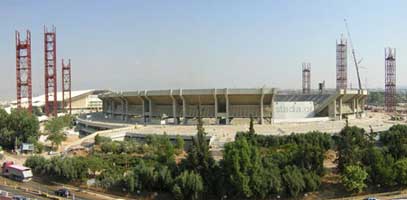
Olympic Stadium - the temporary towers to support the arches have been built
The Athens
Hash House Harriers guide to
Olympic Games 2004 construction progress
An ongoing
record...up to the games on 13-29 August 2004
Jump
to: July 2003 October
2003 November
2003
March
2004 April 2004 May
2004 June
2004
Notes

Artists impression of the completed Olympic Stadium
- July 2003 -

Olympic Stadium - the temporary towers
to support the arches have been built
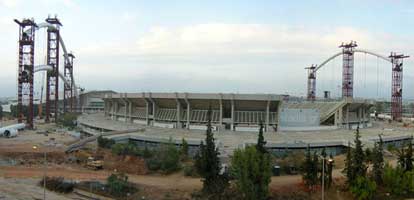
Olympic Stadium - the construction of the roof arches begins
- November 2003 -
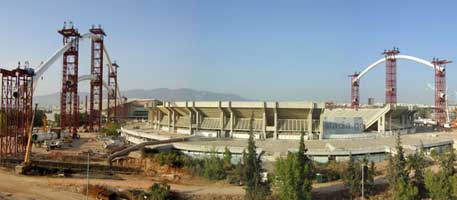
Olympic Stadium - more sections are delivered &
end-towers are added - early November

Olympic Stadium
- Santiago Calatrava roof - constructing a steel arch - November 19
(the men on the tower give an idea of scale)

Olympic Village -
some of the 366 buildings - at the base of mount Parnitha

Olympic Village - building the double security wall around the village

Olympic Stadium
- rapid
progress - view from Pendeli mountain behind Kefalari
- 30th November
-
March 2004 -
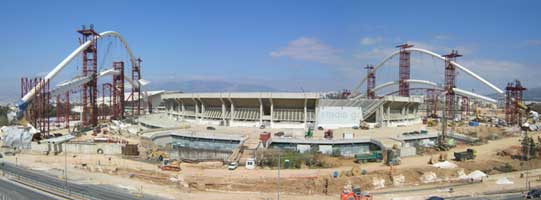
Olympic Stadium - the giant arches are almost complete

Main swimming pool
of the Aquatic Centre - 2nd March
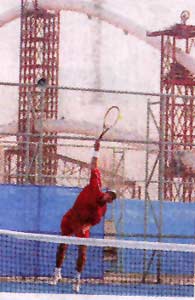
International tennis
tournament - with the Olympic Stadium roof arches in the background - 20th March

Transport Minister inspects Athens Tramline progress

Canoe - kayak slalom training
area in Hellenikon (the site of the former International airport)
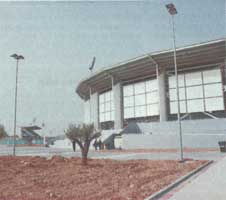
Baseball centre - Hellenikon
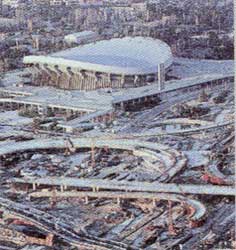
Faliro complex under construction
(Note the additions to the
original Peace & Friendship stadium)
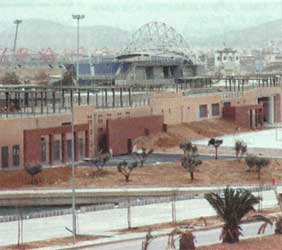
Faliro complex

Faliro esplanade
-
May 2004 -

Main Olympic Stadium Site
The whole (new) layout of the site was designed by Spanish architect Santiago
Calatrava
(Note the Olympic Stadium & the the two main roof arches before moving -
at bottom right)

View of Main
Olympic Stadium from atop east arch tube - 2nd May
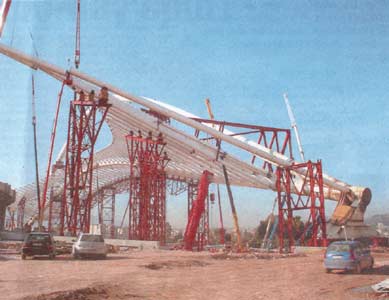
Main Olympic
Stadium - Santiago Calatrava roof - One half before the move on tracks
The completed roof will weigh 18,000 tons!
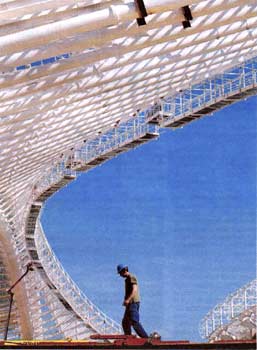
Main Olympic
Stadium - the western arch (1st half) of the Calatrava roof -
starting it's move on the 10th May

Main Olympic site - Olympic
Velodrome - Santiago Calatrava roof
The roof panels are being installed

Olympic Velodrome
- Santiago Calatrava roof

Inside the
Olympic Velodrome

Main Olympic
Stadium site - Steel Promenade Cover - designed by Santiago Calatrava

Transport
Minister inspects new Athens Metro train - 10th May

Athens Mayor
Dora Bakoyannis inspects new sanitation vehicles - 10th May

Olympic commemorative 2-Euro
coin - issued on the 13th May
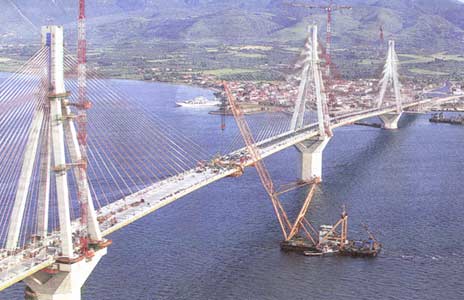
Rio-Antirrio
bridge (crossing the Gulf of Corinth) - 20 May
The 2, 252 metre bridge will be completed 4 months ahead of schedule.
It used 80,000 tonnes of steel and cost 740 million Euros. It has the longest
suspended deck in the world (yes, even longer than the San Francisco Golden
Gate bridge).
A torchbearer carrying the Olympic flame is scheduled to cross the bridge on
the 8th August, a week ahead of the Olympic opening ceremonies.
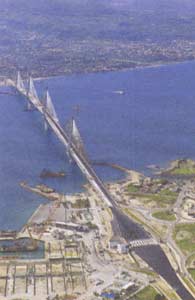
Rio-Antirrio
bridge - 20th May
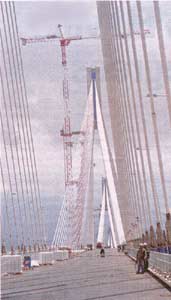
Rio-Antirrio bridge - 20th May
-
June 2004 -

June 10th - the (not quite complete) Olympic Stadium opens for June 10-12 athletics
championship - test event.
Notice seats and roof panels still to be installed.
International track cycling & swimming competitions were also held during
this period.

June 10 - Greek athlete
Yiorgos Vomvelis runs in a 400m heat

June 10 -
Greek athlete Tassoula Kelesidou throwing the discus
(she set a new Greek record)
(0) Olympic Games is OLYMPIAKI AGONES in Greek.
(1) Santiago Calatrava is a Spanish architect working in Paris and Zurich who
is recognized as one of the world's innovative architects. Trained as a sculptor,
an engineer, and an architect, he synthesizes new technologies and new forms
in all his projects, including a memorable bridge in Barcelona and train stations
in Zurich and Lyon. His work transcends the traditional boundaries between art
and architecture as well as between engineering and architecture. Calatrava's
projects have won critical acclaim internationally and are widely published
both in Europe and in the United States. © Smithsonian Institution.
(Website: http://www.calatrava.com )
(2) The the domed roof of the main Olympic Stadium - as originally designed
by architect Santiago Calatrava- was to weigh 13,000 tons. In 1999 the Athens
earthquake was strongly felt around the Olympic Stadium, where stream deposits
created a "precarious soil layer" up to 50 metres deep. The foundation
plans submitted by Calatrava in January had to be modified because they did
not take these factors into account. The changes boosted the dome's weight by
5,000 tons increasing it to 18,000 tons.
(3) The two halves (arches) of the Olympic Stadium dome (each over seventy metres
at their highest point) have been assembled and then slid into place along about
64 metres of reinforced concrete beams with rails. The task could only be undertaken
in winds under four Beaufort. Time was saved by installing over a third of the
planned glazing before the dome move. The completion of the move of the second
half of the dome was on Friday 4th June 2004.
(4) The Olympic Stadium's roof will require 25,000 square metres ( 25 stremmata)
of blue glass panels to complete the 55 million-euro project.
(5) The Olympic Stadium's surrounding complex is known as the
OAKA. To see other images from the stadium construction company go to the website:
http://www.stadia.gr/oaka-new.html
(6) The Olympic Velodrome's 4,000 ton roof was moved (without publicity) into
place during the National Day weekend (27-28 March, 2004) and very sensibly
announced only after it was successfully completed.
- Another Mad Dog special section -
(Acknowledgement to the Athens News & Stadia)